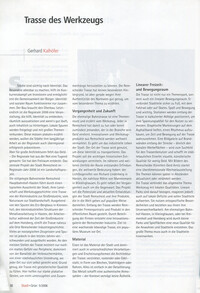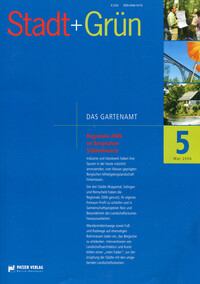

Path of the Tool: Identity of the city
Cities are addicted to identity. Making what is special can be read helps in the competition for investors and only enables the commonality of the citizens. Identity and social space only work together. The building needs the superstructure. Ultimately, the Regionale 2006 is an event that helps to discover identity, to express it spatially and, if things go well, to store content. Local traces are exposed and linked to major issues. These have to be told in a striking way if the cities want to present their long-term work on the Regionale successfully across the region. But there is not enough money for large architectures. - The Regionale has made a virtue out of necessity: it has discovered freedom. The central project of the city of Remscheid in the regional year 2006 is a landscape project. The disused railway line Remscheid Hauptbahnhof-Hasten leads through a typical section of the city, its landscape and tool history: a route from small industry to large-scale industry, from natural space to urban landscape. Based on the traces of ore mining in Kremenholl, the small industrial structures of metal processing in Hasten, the working-class culture during the time of large-scale industry on the Honsberg, the route touches almost every place in Remscheid’s industrial history. Much of the nostalgic evidence and traces, however, has disappeared and wiped out in recent years. At most points along the route, there is only a dull feeling of periphery, dominated by the banality of the hypermarkets, by urban disorder, where each place only does justice to itself. Reason enough to fill the route with design quality. Only strong, striking gestures help here, so as not to drown and to be able to establish connections. The Remscheider route has no special background, but precisely because of its authenticity of the normal it is good enough to talk about the special topic.
Past and future The former railway line is a themed route and tells about tools. Everyone in Remscheid has something to do with it or at least knows someone who makes his living in the industry. Innovations and tool products from Remscheid are marketed worldwide. It’s about the industrial life of the city. The location of the route is used to convey this identity. The project aims to convey the important historical developments. In the closer and further surroundings of the route inventions were made that are of worldwide importance: the electric arc furnace from Richard Lindenberg in Hasten, the seamless tube from Mannesmann in Bliedinghausen. In addition to the past, it is also about the present. The project aims to present the potential and current developments in the city of Remscheid and its products that are being launched into the world in a popular way. Remscheid company portraits and products are placed in the public space along the route. With the participation of the companies, an innovation gallery of the Remscheid industry is created. The goal is a growing lively route, a popular local museum.
material
Iron is the material of the city and also dominates the architecture of the route in different finishes and forms: galvanized, rusting or stainless steel, in the form of sheet metal, steel girders or pipes. Everything is simple in the detailing. The metal creates an authentic atmosphere - the context does not tolerate any
aesthetics
Linear leisure and exercise space The route is not only a theme park, but also a linear exercise space. It connects parts of the city safely on foot, by bike or on skateboarding. Fun and exercise are important. Stations are positioned along the route in a calculated sequence in order to avoid a voltage drop for the user. Graphic markings on the asphalt strip help to build a rhythm in order to perceive time and movement on the route. A picture gallery on fire walls along the route - similar to the banal advertising space - becomes a search image for the route user and creates visual, artistic quality for little money in the monotony of urban planning. An oversized temporary exhibition starts with pictures by the Remscheid artist Gerd Arntz. The topics can be updated or changed at intervals later. The route combines the general subject of tools with local qualities. Linear parks are related to this, but also react to local deficits and are intended to upgrade districts. They use site-specific features and derive their uniqueness from them. At the former Hasten train station, in Vieringhausen, or near Kremenholl and Honsberg, small parks and play areas will create a new quality for residents and districts. The big issue must also affect the districts.
